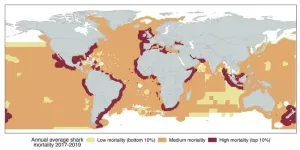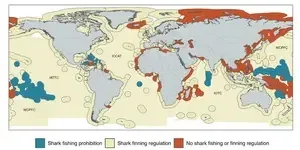(Press-News.org) Sharks have persisted as powerful ocean predators for more than 400 million years. They survived five mass extinctions, diversifying into an amazing variety of forms and lifestyles. But this ancient lineage is now among the world's most threatened species groups due to overexploitation in poorly regulated fisheries and the proliferation of wasteful finning practices.
Governments around the world have introduced a host of regulations aimed at reducing shark catch and finning, the latter of which typically sees valuable shark fins retained for sale while carcasses are discarded at sea. But until now, there was no assessment of how effective these measures have been. A new, global assessment revealed that, while some regulations do work, overall, sharks are caught by coastal fisheries at increasing rates.
The results, published in the journal Science, are the product of an international team of researchers working to understand trends in shark mortality across 150 fishing countries and in the high seas. They examined shark catches from 2012 to 2019 — a time when many new regulations were implemented — to see whether conservation measures reduced species losses. They also conducted in-depth interviews with shark fishery experts to better contextualize current trends in shark finning and fishing practices. In all, the dataset tracked the fates of an estimated 1.1 billion sharks caught by fisheries around the world.
Led by researchers at Dalhousie University, UC Santa Barbara and The Nature Conservancy, the team came to a surprising conclusion. They found total shark fishing mortality increased from 76 million to 80 million sharks per year even though protective legislation to reduce finning increased more than 10-fold during the same time. More than 30% of this catch was for species currently threatened with extinction. When also accounting for sharks not properly identified by species, the global mortality estimate rose to 101 million sharks in 2019.
“The unsustainable fishing of sharks is a global problem of staggering proportions that could eventually lead to the extinction of some of our planet’s most ancient and revered species,” said senior author Darcy Bradley, an adjunct faculty member at UC Santa Barbara and a scientist with the Nature Conservancy in California. “We found that despite myriad regulations intended to curb shark overfishing, the total number of sharks being killed by fisheries each year is not decreasing. If anything, it’s slightly increasing.”
The increase came primarily from coastal shark fisheries. These activities account for 95% of total shark fishing mortality globally in terms of the number of individual sharks caught and killed. Shark mortality in these fisheries increased steadily by 4% between 2012 and 2019. This contrasted with regulated open-ocean fisheries, especially across the Atlantic and western Pacific, where shark mortality decreased by an estimated 7%.
“We show that widespread legislation designed to prevent shark finning was successful in addressing this wasteful practise but did not reduce mortality overall,” said lead author Boris Worm, a research professor in the Department of Biology at Dalhousie University in Nova Scotia. “Too many sharks are still dying; this is especially worrisome for threatened species such as hammerheads.”
The team also analyzed the relationship between shark catches and shark fishing regulations by country, finding that shark fishing prohibitions and accountable governance were the only measures associated with reduced mortality.
"Complete bans on shark fishing, through protective measures such as shark sanctuaries can be successful, highlighting an opportunity to prioritize these and other area-based conservation measures,” explained Bradley.
Nearly 70% of maritime jurisdictions around the world have introduced some regulatory measures to eliminate shark finning and associated fishing mortality, little of which existed 20 years ago. “The amazing thing is that it’s not just one or two countries, but that all around the world, governments and some fishing companies have committed to eliminating finning, often in response to public pressure. The challenge now is to build on this momentum and get stronger measures in place to reduce shark catches overall”, said co-author Laurenne Schiller, a post-doctoral fellow at Carleton University, Ottawa.
While the researchers found that finning prohibitions likely reduced shark finning at sea, these regulations had little effect on mortality overall. In fact, they may have even increased catches, possibly by incentivising the full use of sharks and creating additional markets for shark meat and other products.
Co-author Leonardo Feitosa, a shark biologist from Brazil now working at UC Santa Barbara, explained: “We have seen the demand for shark fins decreasing and the demand for shark meat increasing, with Brazil and Italy being the main consumers. Because shark meat is a relatively cheap substitute for other types of fish, there is considerable mislabeling, making some consumers eat shark meat without their knowledge.”
The authors conclude that shark fishing continues to present a substantial threat to shark populations, but that proven solutions are working where they are applied. “It’s clear from our analysis that cracking down on shark finning is not enough,” said Echelle Burns, a data scientist at UC Santa Barbara. “More specific measures that address shark mortality — like prohibiting fishing in certain areas or requiring fishers to release vulnerable species that they accidentally caught — can help protect more sharks.”
“Effective conservation actions for sharks are often impeded by lack of community-based awareness and stewardship projects,” added co-author Nidhi D’Costa, a shark researcher from Bangladesh now working at Dalhousie. “This is especially crucial in countries where small-scale artisanal fisheries are a major driver of shark mortality.”
The authors recommend combining geographic protections with fishing regulations to improve the outlook for sharks. New policies need to specifically discourage the retention of overfished and threatened species and help reduce shark bycatch. They also stress the importance of accountability of fleets, fishing companies and management bodies to support the successful implementation of these measures.
“Our analysis highlights the need for improved transparency and reporting requirements,” explained Sara Orofino, a data analyst at UC Santa Barbara. “Shark catches are often self-reported, aggregated into broad groups, and crucial information on discarding practices is often lacking. Accurate, comprehensive, and accessible data are critical to effectively evaluate how well regulations are working in safeguarding sharks and other threatened species.”
Maria Deng Palomares, senior scientist and project manager at the Sea Around Us initiative, University of British Columbia concludes: “There is a path forward to avoid a global extinction crisis for sharks, but the time to act is now.”
END
A global study reveals pathways to save threatened sharks, despite rising mortality trends
Even with widespread regulations, increasing shark mortality has created 'a global problem of staggering proportions'
2024-01-11
ELSE PRESS RELEASES FROM THIS DATE:
Discovered in the Upper Amazon: 2500-year-old landscape providing evidence for early urbanism in the region
2024-01-11
A dense system of pre-Hispanic urban centers, characterized by constructed platforms and plazas and connected by large, straight roads, has been discovered in the upper Amazon, according to a new study. The research, based on more than 20 years of interdisciplinary research, suggests that this original 2500-year-old society constitutes the earliest and largest low-density agrarian urbanism documented in the Amazon thus far. Such extensive early development in the Upper Amazon resembles similar Maya urban systems in Central America. ...
Machine learning clinical prediction models fail to generalize across trial data
2024-01-11
Clinical prediction models for schizophrenia treatment outcomes that work well within the trials from which they were developed fail to generalize to future trials, according to a new study. “The findings not only highlight the necessity for more stringent methodological standards for machine learning approaches but also require reexamination of the practical challenges that precision medicine is facing,” writes Frederike Petzschner in a related Perspective. Despite receiving the same treatments for the same afflictions, some patients get better while others show no improvement. Precision medicine approaches seek to address this problem by providing tailored treatments for individual ...
Shark fishing mortality on the rise despite regulatory change
2024-01-11
Despite widespread legislation and fishing regulations aimed at reducing wasteful shark finning practices, global shark fishing mortality is still on the rise, researchers report. The findings suggest that improved regulations are needed to reverse the continued overexploitation of these species. Over the last several decades, sharks have been increasingly recognized as some of the planet’s most threatened wildlife. Increasing shark mortality has been driven in part by overfishing – large numbers of sharks are often captured as bycatch in tuna ...
Comprehensive assessment reveals high extinction risks for thousands of Atlantic Forest trees in eastern South America
2024-01-11
A comprehensive analysis of tree species’ conservation statuses across Atlantic Forest trees reveals high extinction risks. According to the report, roughly two-thirds of the 4950 tree species living in this biodiversity hotspot are threatened with extinction. This includes 82% of endemic species, which have quite limited geographic ranges. Based on these findings, the authors suggest that the conservation status of tropical forests worldwide may be worse than previously believed. Conservation efforts and decisions often ...
Lab-grown retinas explain why people see colors dogs can’t
2024-01-11
With human retinas grown in a petri dish, researchers discovered how an offshoot of vitamin A generates the specialized cells that enable people to see millions of colors, an ability that dogs, cats, and other mammals do not possess.
“These retinal organoids allowed us for the first time to study this very human-specific trait,” said author Robert Johnston, an associate professor of biology. “It’s a huge question about what makes us human, what makes us different.”
The findings, published in PLOS Biology, increase understanding of color ...
KAUST scientists unveil blueprint for affordable solar cells to power Saudi Arabia and beyond
2024-01-11
Thuwal, Saudi Arabia, Month Day, Year – Scientists at King Abdullah University of Science and Technology (KAUST) have unveiled a roadmap for bringing perovskite/silicon tandem solar cells to market, paving the way for a future powered by abundant, inexpensive clean energy in Saudi Arabia and the world.
The authors of the article, published in esteemed journal Science, include Prof. Stefaan De Wolf and his research team at the KAUST Solar Center.
The team is working on improving solar efficiency to meet Saudi Arabia’ solar targets.
Perovskite/silicon tandem technology combines the strengths of two materials – perovskite's efficient ...
Quest for personalized medicine hits a snag
2024-01-11
New Haven, Conn. — The quest for personalized medicine, a medical approach in which practitioners use a patient’s unique genetic profile to tailor individual treatment, has emerged as a critical goal in the health care sector. But a new Yale-led study shows that the mathematical models currently available to predict treatments have limited effectiveness.
In an analysis of clinical trials for multiple schizophrenia treatments, the researchers found that the mathematical algorithms were able to predict patient outcomes within the specific ...
Bridging light and electrons
2024-01-11
When light goes through a material, it often behaves in unpredictable ways. This phenomenon is the subject of an entire field of study called “nonlinear optics”, which is now integral to technological and scientific advances from laser development and optical frequency metrology, to gravitational wave astronomy and quantum information science.
In addition, recent years have seen nonlinear optics applied in optical signal processing, telecommunications, sensing, spectroscopy, light detection and ranging. All these applications involve the miniaturization of devices ...
Climate change spells disaster for termite-loving numbats
2024-01-11
Australia is known for its wonderous and unique wildlife. But, just like the rest of the world, Australia is expected to get even hotter because of climate change. This could spell disaster for many of the marsupials that call the drier regions of the country home as it may get too hot for them to handle. To make things even more difficult, many of these marsupials are endangered thanks to habitat loss and introduced species such as domestic cats and red foxes. Therefore, finding a way to study these animals without disturbing them is critical to ensure their survival. This realisation led Christine Cooper (Curtin University, ...
ACIP releases 2024 Adult Immunization Schedule featuring four new vaccines
2024-01-11
Embargoed for release until 1:00 p.m. ET on Thursday 11 January 2024
Annals of Internal Medicine Tip Sheet
@Annalsofim
Below please find a summary for new article that will be published in of Annals of Internal Medicine. The summary is not intended to substitute for the full articles as a source of information. This information is under strict embargo and by taking it into possession, media representatives are committing to the terms of the embargo not only on their own behalf, but also on behalf of the organization they represent.
-------------------------------------------------
ACIP ...
LAST 30 PRESS RELEASES:
Heart-brain connection: international study reveals the role of the vagus nerve in keeping the heart young
Researchers identify Rb1 as a predictive biomarker for a new therapeutic strategy in some breast cancers
Survey reveals ethical gaps slowing AI adoption in pediatric surgery
Stimulant ADHD medications work differently than thought
AI overestimates how smart people are, according to HSE economists
HSE researchers create genome-wide map of quadruplexes
Scientists boost cell "powerhouses" to burn more calories
Automatic label checking: The missing step in making reliable medical AI
Low daily alcohol intake linked to 50% heightened mouth cancer risk in India
American Meteorological Society announces Rick Spinrad as 2026 President-Elect
Biomass-based carbon capture spotlighted in newly released global climate webinar recording
Illuminating invisible nano pollutants: advanced bioimaging tracks the full journey of emerging nanoscale contaminants in living systems
How does age affect recovery from spinal cord injury?
Novel AI tool offers prognosis for patients with head and neck cancer
Fathers’ microplastic exposure tied to their children’s metabolic problems
Research validates laboratory model for studying high-grade serous ovarian cancer
SIR 2026 delivers transformative breakthroughs in minimally invasive medicine to improve patient care
Stem Cell Reports most downloaded papers of 2025 highlight the breadth and impact of stem cell research
Oxford-led study estimates NHS spends around 3% of its primary and secondary care budget on the health impacts of heat and cold in England
A researcher’s long quest leads to a smart composite breakthrough
Urban wild bees act as “microbial sensors” of city health.
New study finds where you live affects recovery after a hip fracture
Forecasting the impact of fully automated vehicle adoption on US road traffic injuries
Alcohol-related hospitalizations from 2016 to 2022
Semaglutide and hospitalizations in patients with obesity and established cardiovascular disease
Researchers ‘listen in’ to embryo-mother interactions during implantation using a culture system replicating the womb lining
How changing your diet could help save the world
How to make AI truly scalable and reliable for real-time traffic assignment?
Beyond fragmented markets: A new framework for efficient and stable ride-pooling
Can shape priors make road perception more reliable for autonomous driving?
[Press-News.org] A global study reveals pathways to save threatened sharks, despite rising mortality trendsEven with widespread regulations, increasing shark mortality has created 'a global problem of staggering proportions'





